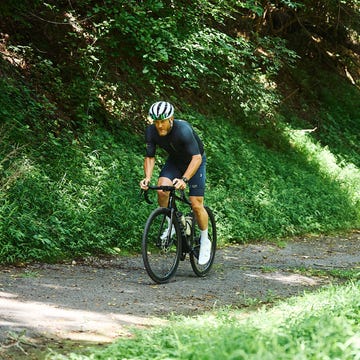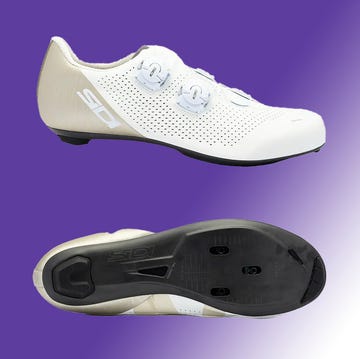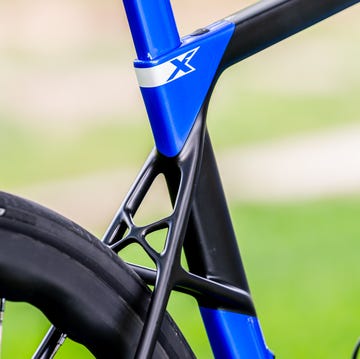Racers love lightweight bikes because they help maximize your effort—fewer wasted watts. Those watts add up throughout a daylong race; you want to conserve energy wherever possible to have power when needed. While aerodynamic gains ultimately surpass weight in many situations, lightweight bikes have a psychological grip on cyclists.
However, not only do professional racers benefit from light bikes; any cyclist riding long miles or spending many hours in the saddle can appreciate a lightweight bicycle. And for those riders, there might not be a better new road bike than Scott’s radically lightweight Addict RC. The Addict RC is a modern race bike with solid geometry, stellar handling, and clearance for up to 34mm wide tires. It’s an exceptional bike for racing, spirited riding, and long-distance rides on pavement—or even on smoother gravel or dirt sections.
An Undeniable Appeal
Even in the current era of aero-optimization, lightweight bikes possess a magical quality. Light bikes seem to dance up climbs with added grace, float like hummingbirds over smooth tarmac, and rapidly reply to inputs of power. Plus, a lightweight bike will impress even your most jaded cycling friends when they pick it up.
I am that jaded cycling friend, and the Scott Addict RC’s weight impressed me before I even rode the bike. Scott’s product info listed the Addict RC Pro at 14.33 pounds; that is certainly light, but brands often list rather optimistic product weights. When my test bike arrived, I initially wondered if Scott sent me only a frameset or shipped the wheels in a separate package because the box felt impossibly light.
Lightweight road race bikes routinely come through Bicycling’s doors for testing, but none flirted this close to the UCI’s 14.99-pound minimum weight requirement in my 58cm framesize. Without pedals or bottle cages, the Cervélo R5 with Force AXS at 16.7 lb., Ridley Falcn RS with Ultegra Di2 at 16.01 lb., and Pinarello Dogma F with Dura-Ace Di2 at 15.4 lb. were a few of the lightest road bikes I rode in the past three years. Even the Cannondale Supersix Evo Lab 71 I assembled last spring with new Red AXS (while attempting to build a sub-15-pound bike) came in at 15.75 pounds with pedals, cages, and a computer mount.
The Scott Addict RC Pro tipped the scales at a scant 15.14 pounds. That is in an XL/58cm frame size, including Garmin Rally pedals, two cages, a computer mount, a hidden tool, and sealant in the tires.
How Did They Get Here?
To beat the UCI’s minimum weight requirement, riders often use boutique parts from small manufacturers, insanely light wheels, or even modified components to tease out every milligram. When brands construct impressively lightweight production bikes, they cut grams using special edition framesets with less paint or fancy carbon layups, carbon-spoked wheelsets, and compact gearing to avoid excess weight.
Scott does not employ any of these tactics on the Addict RC Pro. My 58cm bike comes pretty darned close to the 14.99 pound target with a standard frameset, full Shimano Dura-Ace Di2 drivetrain (using 52/36T chainrings and 11-34T cassette), tubeless carbon wheelset with DT Swiss 240 hubs and Aerolite stainless steel spokes, and 30mm wide Schwalbe Pro One tubeless tires. (In case you’re curious, Scott also makes an Addict RC Ultimate model with a lighter weight frame and fork, one-piece carbon wheels, 29mm tube-type tires, and SRAM Red AXS with compact gearing. It weighs a claimed 13.01 pounds and costs $15,000.)
The engineers at Scott took a systems approach to shave weight to reduce the frame kit (frame, fork, and associated parts) by over 300 grams compared to the previous generation Addict RC that debuted as a 2020 model. The team achieved the lower weights using carbon molding techniques previously employed on the brand’s mountain bikes. They also improved the carbon layup, reduced the number of carbon pieces and joints, and pulled grams from other parts like the cockpit, axles, and headset parts.
“Thanks to the smooth surface of the inflatable preform core, the inside of the frame is super clean and does not have any signs of voids or wrinkles,” the brand states. Scott explains that the process removes the excess resin during molding and leaves “only what’s really necessary for stiffness and strength.” And since the molding process has consistent pressure across the frame surfaces, it “ensures optimal compaction of the layup”. Scott claims that some areas of the frame see wall thickness reduced to about 0.6mm.
The Ride Quality
Unfortunately, despite their cool-factor, some lightweight bikes feel erratic when descending or heavy braking, flexy under power, or simply can’t hang with heavier-weight aerobikes on flat segments. And all of Scott’s weight-saving efforts would be for nought if the Addict RC rode like a dog.
Luckily, the only dog it resembles is a greyhound. The RC Pro is a purebred road race bike; it is flat out fast in every situation I put it through. I am not a naturally gifted climber, but I eagerly reach for the Addict for rides with any notable elevation gain. The bike glides up double-digit gradients even with its non-compact gearing.
On rolling terrain, the Addict RC holds its own against aero-optimized bikes. While it does not have the hyper-speed rush of an all-in aerobike (like Scott’s Foil RC) on flat pavement, it also doesn’t feel like a sail in a crosswind or like you are bruising a kidney on washboard sections of road. The Addict is aerodynamic enough for everyday rides, particularly for riders who regularly ride in the hills.
The Addict RC excels surprisingly well on descents—the bike rips. It elicited wide grins and silly giggles from me the first time I let off the brakes and pushed the Addict deep into a turn. Scott’s choice of grippy 30mm wide Schwalbe tires inspires confidence and adds control when the road tilts downwards, particularly when turns are involved. It should be fun watching noted daredevil descender Tom Pidcock racing on the same Addict RC HMX frame this season.
However, it’s not only the wide tires that add confidence and control. You gain comfort and grip when you install bigger tires on a road bike, but putting higher volume tires on a frame not designed around them will raise the bottom bracket height and alter the bike’s handling.
Scott’s product team and engineers optimized the Addict RC’s handling around the 30mm width tires and 25mm ID rims. “Larger tires have the tendency to make the handling of a bike more lazy/sluggish as they increase the fork trail,” a Scott representative told me. He added, “We adapted head tube angles and fork trails and developed a specific stiffness layout (with a stiffer rear-triangle) to compensate for this effect and recover the agility and ‘snappy’ handling that we were used to from riding with narrower tires.”
The Addict RC has an “in not on” sensation that I like from bikes. It’s a feeling that the rider’s center of mass is positioned lower on the bike and balanced for stability and predictable handling. The new Addict is low and long; it has more BB drop, a longer reach, and a lower stack than the previous generation model. It is also lower and longer than most competitors in the category.
Unfortunately, the longer reach meant that my preferred fit was unachievable with the stock cockpit. If you like long and low race bikes, you will get on well with the Addict RC’s fit. However, the sizing is slightly unconventional, and the long stem (120mm on the 58cm) and 15mm offset post stretched me out on the bike more than desired. I opted for a 5mm offset post since it was simpler than swapping the stem.
The brake hoses are internally routed (as is now normal on high-end race bikes), but due to the unique steerer tube, you cannot use a traditional bar and stem on the Addict RC. The steerer tube is round but has a 27.2 mm diameter; not 1-inch (25.4mm) as on the Foil RC, nor 1-⅛ inch (25.58mm) as on many road bikes. Scott claims this new size was required “for a good stiffness-to-weight ratio” and to use its new fork manufacturing process. So, you’re locked into Syncros units. Be sure to triple-check the measurements and listed dimensions before you cut down a steerer tube or post (also, expect to pay extra for labor to route hoses and install a new bar if needed).
Final Impressions
Overall, the bike is easy to live with. The cockpit components use a T25 Torx to adjust (a combo T25/M6 is neatly hidden in the bar end). Also, hat-tip to Scott’s product team: The Addict RC has a 120kg/265 lb. system weight limit (rider plus bike plus gear). This allows some bigger-bodied cyclists to ride and enjoy a lightweight machine.
I don’t have many component qualms with the RC Pro (aside from the quirky steerer diameter). Most parts on the Addict perform exceptionally well; problems are rare when a bike has a full Shimano Dura-Ace drivetrain and rolls on DT Swiss 240 hubs. One note: Scott does not equip the Addict RC Pro with a power meter, so expect to bring your crank-based system or add power pedals (as I did for my testing).
Keeping air in the stock Schwalbe tires is the only ongoing issue for the Addict RC Pro. The tires are grippy, but pick up glass, small stones, and road debris. Keep this in mind if you live in an area with unkept roads. Silca’s new sealant cut down on leaks, but my rear tire has a couple of Dynaplugs.
Scott’s Addict RC should be on your short list if you seek a lightweight road or race bike this season. It rides like a race bike but with the geometry, tire clearance, and versatility many all-road bikes claim but rarely attain. The Addict’s weight, handling, and tech are right up there with (or exceed) the Tarmac SL8, the benchmark bike in the road race category.
If the RC Pro’s nearly $9,000 price tag is too steep for your budget, Scott offers Ultegra and 105 Di2-equipped Addict RC models using the same frame and fork starting at $4,999.
As Deputy Editor, Tara Seplavy leads Bicycling’s product test team; after having previously led product development and sourcing for multiple bike brands, run World Championship winning mountain bike teams, wrenched at renowned bicycle shops in Brooklyn, raced everything from criteriums to downhill, and ridden bikes on six different continents (landing herself in hospital emergency rooms in four countries and counting). Based in Easton, Pennsylvania, Tara spends tons of time on the road and trail testing products. A familiar face at cyclocross races, crits, and bike parks in the Mid Atlantic and New England, on weekends she can often be found racing for the New York City-based CRCA/KruisCX team. When not riding a bike, or talking about them, Tara listens to a lot of ska, punk, and emo music, and consumes too much social media.























